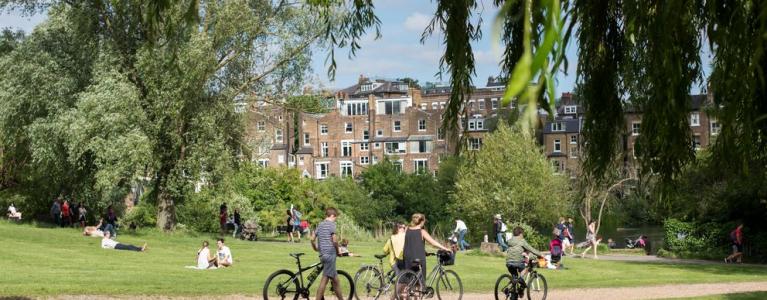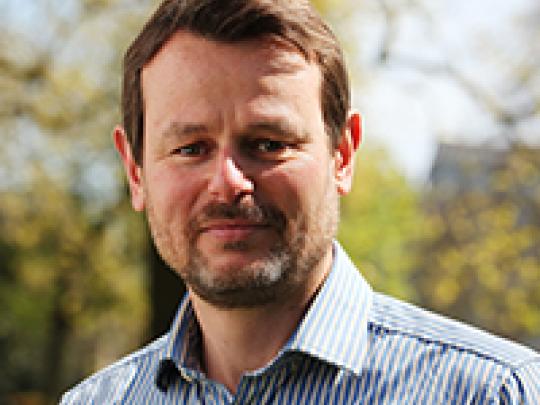
By David Elliott, commissioner on the London Sustainable Development Commission
Imagine a city where nature is not properly valued.
Where green space is viewed as 'wasted' space, an economic ‘missed opportunity’.
What kind of city might this create?
Let’s visit such a city and find out…
Authorities are instructed to concrete over any and all open and green spaces – no questions asked – to pave the way for office space. These new frontiers are offered to developers at peppercorn prices so long as investment can get buildings upwards at record speeds. Budgets to plant and look after trees are now declared a pure luxury – and chainsaw gangs are dispatched to all corners to get rid of these supposed obstacles of progress. ‘Gravel grants’ are handed out to homeowners to tarmac their lawns – which the city views as parking-spaces in waiting.
Money cascades in, and the economy booms… at least in the short term.
But a spike in cases of lung disease, with children worst hit, makes the headlines as air pollution soars. Summer city temperatures the following year hit four degrees above average. A wet winter brings unprecedented local flooding as there is nowhere for the water to go, and insurance claims rocket. Ambient noise levels have become an intrusive day and night attack on the psyche. Pigeons thrive, but there is no song in the air.
Children are heard, but not seen – retreating to their bedrooms with screens and headphones. A reduction in outdoor activity is linked to obesity and heart disease crises. Levels of depression seem to go viral, costing immeasurable losses to work days and productivity.
The loss of green spaces that had created a sense of place, a connection to the past and spaces for people to come together, has catalysed a fragmentation of communities. House prices collapse as people scramble to move out of a city no longer seen as a place that can provide conditions for decent, or acceptable, living…
The End.
Perhaps though this is a simplistic dystopian fantasy. Perhaps. But taking green for granted is risky business… and an incredibly short-sighted view of just how valuable is to a city, and its citizens. The benefits of access to natural green spaces – in terms of health, happiness and prosperity – are widely documented, including in the London Sustainable Development Commission’s ‘Sowing the Seeds’ report.
Now imagine this city…
The city’s nature is valued, not least for the many benefits it brings its citizens.
Its green spaces are augmented, trees are protected, the natural environment is enhanced. New developments are designed from the outset with green at their core. Butterflies, birds and bees, and other wildlife are frequent visitors to the green infrastructure built into new and existing developments, which also helps to regulate temperature and reduce the impact of floodwater.
The air is cleaner; citizens – including children – congregate, play, and find tranquillity in the many, accessible-to-all open and green spaces. The next generation is healthier, happier, safer, develops a sense of place, and is ultimately more prosperous. Investment in green space has proven not to be a cost, but something that has paid back in multiples – but it did require vision and concerted effort to not be lured in by short-term temptations. The city is a green and thriving place where people want to live and do business in.
London is endowed with green spaces, large and small. But their distribution is highly uneven, and often the most socially deprived areas are also the most environmentally deprived. The LSDC’s most recent 'Quality of Life Indicators' report showed, for example, that over 20 per cent of Greater London still lies in an area of deficiency in access to nature.
Everyone has a right to enjoy the basket of essential benefits that access to green space offers. The Mayor of London and the National Park City have set ambitious targets to increase the city’s green cover and to make good quality green space more accessible for all Londoners. The National Park City is therefore, in essence, about creating a future city where quality of life and economic prosperity for all are given the best chance of success by investing in the most valuable asset of all: nature.
About the author

David Elliott is a commissioner on the London Sustainable Development Commission. He is Chief Executive of Trees for Cities, a charity that helps create high quality green spaces in socially and environmentally deprived parts of cities and towns across the UK and internationally. He has worked in the non-profit sector for over a decade for several international organisations, originally running landmine clearance and post-conflict recovery programmes across Africa and Asia. Prior to this he was a management consultant for Accenture. He has been a Trustee of the International Tree Foundation and the African Conservation Foundation. David is currently an Adviser for the Forestry Commission's Forest and Woodlands Advisory Committee for London.